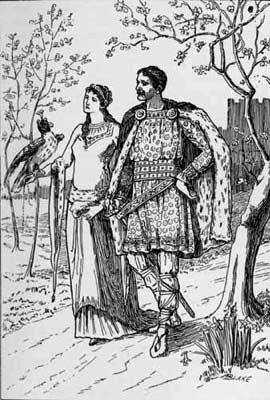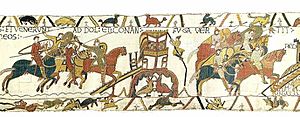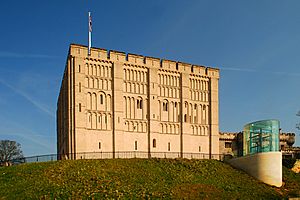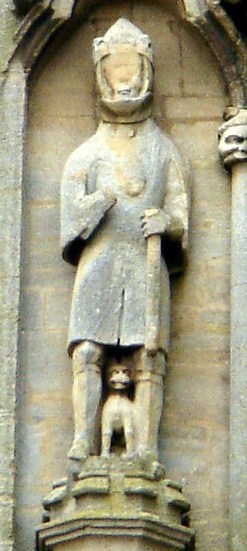Ralph de Gael facts for kids
Quick facts for kids
Ralph de Gael
|
|
|---|---|

The Siege of Norwich Castle
|
|
| Earl of East Anglia, Lord of Gaël and Montfort (Seigneur de Gaël et Montfort). | |
| Personal details | |
| Born | c. 1042 |
| Died | 1100 |
| Nationality | English and Breton |
| Spouses | Emma FitzOsborn, Countess of Norfolk. |
| Children |
|
Ralph de Gaël, also known as Ralph de Guader, was an important figure in England and Brittany during the 11th century. Born around 1042, he held the title of Earl of East Anglia, which covered the areas of Norfolk and Suffolk. He was also a powerful lord in Brittany, controlling the lands of Gaël and Montfort. Ralph is best known for leading the Revolt of the Earls in 1075. This was the last major rebellion against William the Conqueror, the King of England.
Contents
Ralph's Early Life and Family
Ralph de Gaël was born into a noble family around 1042. His father was likely an Earl named Ralph, who lived in England. Ralph had a mixed background, with both English and Breton (from Brittany, France) family roots. Some stories say his family was even connected to ancient Breton kings.
Ralph also had connections to other important people. The Domesday Book, a famous record from that time, mentions an "Alsi" as his nephew. Another person named Godwin was said to be his uncle. There were even possible family ties to the rebel Hereward the Wake. Ralph's wedding showed his connections to both Anglo-Saxon and Danish nobles. He also had large family lands in Brittany.
Inheriting Lands and Titles
Ralph inherited a large area in Brittany called Gaël. This included more than 40 villages. In England, he also received many estates. It is not clear if he became the Earl of Norfolk right after his father died.
After the Norman Conquest, Ralph owned vast lands in Norfolk. He also had property in Suffolk, Essex, and Hertford. King William I later made him the Earl of East Anglia. Some historical accounts suggest that his service to William helped him get back lands that were already his by family right. The chronicler Wace wrote about this in his account of the 1066 conquest.
Before the Revolt of 1075
In 1065, Ralph was with Conan II, Duke of Brittany. They were fighting against Rivallon I of Dol at the castle of Combourg.
Ralph also fought in the famous Battle of Hastings in 1066. He was known for being brave and strong. A few years later, in 1068, he was at King William the Conqueror's court.
In 1069, Ralph defeated a group of Norsemen who had attacked Norfolk and taken over Norwich. Because of his actions, he was made the Earl of Norfolk and Suffolk. This earldom was also sometimes called "of Norwich."
Ralph was with the King in Winchester in April 1069. He signed important documents as "Earl Ralph." He also helped build a church in Norwich, called St Peter Mancroft, and gave it to his chaplains.
Ralph's Marriage
In 1075, Ralph married Emma in Cambridgeshire. Emma was the only daughter of William FitzOsbern, 1st Earl of Hereford. This marriage brought together two very powerful families with large estates. Their families were even connected to old English Saxon kings and queens. Some historians believe that King William I might have seen this powerful alliance as a threat to his rule.
The Revolt of the Earls
King William I did not approve of Ralph and Emma's marriage. Despite this, Ralph and Emma went ahead and got married. At their wedding feast, Ralph, his new brother-in-law Roger de Breteuil, 2nd Earl of Hereford, and Anglo-Saxon Earl Waltheof, 1st Earl of Northumberland made a plan to rebel against the King.
A historian named Orderic Vitalis wrote about why the Earls rebelled. He said that William I often removed anyone he thought might threaten his power. The rebels felt William was unfair and had taken the English crown wrongly. They also believed he did not reward his own soldiers fairly.
The plan for the revolt was discovered when Earl Waltheof changed his mind. He told Lanfranc, the Archbishop of Canterbury, about the plot. Lanfranc tried to convince Earl Roger to stop the rebellion. He also removed Roger and his supporters from the church. Waltheof was put in prison and later executed by William. Many people felt this was a harsh punishment for Waltheof, who was known for being kind. After his death, some people believed Waltheof became a martyr, and stories of miracles at his tomb spread.
Because Waltheof confessed, the rebels did not have enough time to prepare. Ralph quickly left the area near Cambridge and went to Norwich. The King's army, led by bishops Odo of Bayeux and Geoffrey de Montbray, followed him closely. Emma stayed to defend Norwich Castle. Ralph sailed to Denmark to find help. He returned to England with a fleet of 200 ships, but they arrived too late. Instead, they attacked the Norman Cathedral in York.
Defending Norwich Castle
While Ralph was away, Countess Emma bravely defended Norwich Castle. She eventually negotiated terms for herself and her followers. They lost their lands but were allowed 40 days to leave England safely. Countess Emma escaped to Brittany, where Ralph later joined her. Ralph lost all his lands and his title as Earl. Roger, who was more involved in the revolt than Waltheof, was imprisoned but later released when William I died in 1087.
Ralph and Emma both successfully escaped England. They went to Ralph's large family lands in Brittany.
Life as a Baron in Brittany
After escaping England, Ralph and Emma settled in Brittany. Their lands included the area of Gaël and more than 40 villages. They also had Gauder Castle and Montfort Castle. Ralph and Emma lived as important Barons in Brittany.
In 1076, King William I brought an army to France. He tried to attack Ralph at his Castle of Dol. William had the help of Hoel II, Duke of Brittany. However, William suffered a big defeat. The King of France came with a large army to help the Bretons. William lost many men, horses, and treasures. This defeat was so great that William had to make peace with Ralph in 1077.
Ralph continued to be an important figure in Brittany. In 1089, he helped settle a disagreement between monks and chaplains. He also signed a document for Alan IV, Duke of Brittany, in favor of St. George's Abbey. Around 1093, after William I died, Ralph appeared in Normandy as a witness in a legal case.
Ralph's Children
Ralph and Emma had several children:
- William (Guillame) de Gael: He took over his father's title as Lord of Gael. He also claimed the lands of Breteuil after his uncle William de Breteuil died in 1103. However, William de Gael died soon after.
- Alain de Gael: He went with his parents on the First Crusade.
- Raoul II de Gael: He was the youngest son but inherited his father's estates in Gael and Montfort. Like his father, Raoul II was a very skilled warrior. By 1119, he also gained control of Breteuil in Normandy. He had several children, including a daughter named Amice. Amice was first engaged to Richard, a son of King Henry I of England. But Richard died in the White Ship disaster in 1120. Amice then married Robert de Beaumont, 2nd Earl of Leicester in 1121.
Raoul II's other descendants continued to hold the family lands in Brittany. His son, Guillame, inherited the barony of Montfort after Raoul II died in 1142. Guillame was known for being more peaceful. He strengthened Montfort Castle and founded abbeys. The family line continued, and they gained more lands in the 15th century.
Journey to the Holy Land
In September 1096, Ralph, his wife Emma, and their son Alain joined the First Crusade. They traveled with Robert Curthose, who was King William I's second son. After spending the winter in Italy, they crossed to Epirus and joined another army. They reached Nicaea in June 1097. Ralph was one of the Breton leaders who helped in the siege of Nicaea.
After this, they joined the division of the army led by Bohemund I of Antioch. Ralph is mentioned fighting again at the Battle of Dorylaeum on July 1, 1097, with his son Alan. Ralph and Emma died in the Holy Land. They saw the capture of Jerusalem in 1099 but passed away the following year on the road from Jerusalem.








